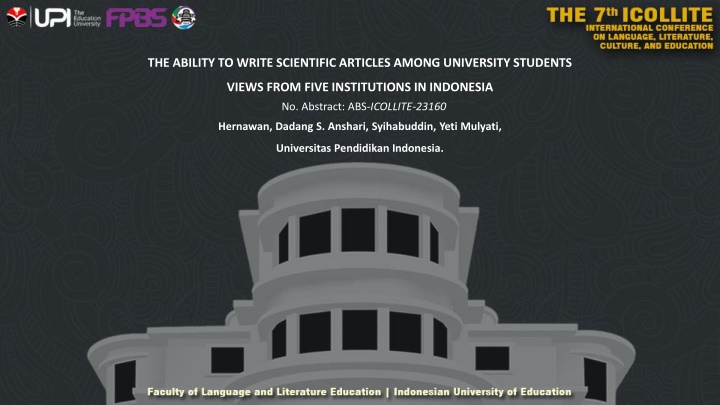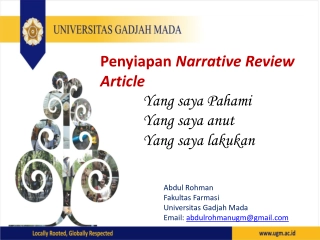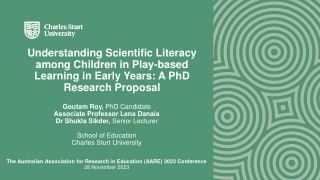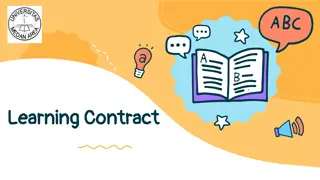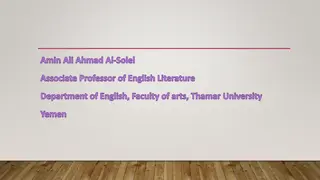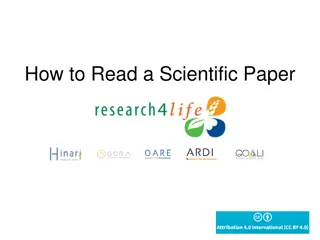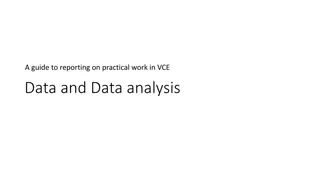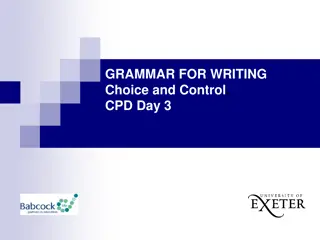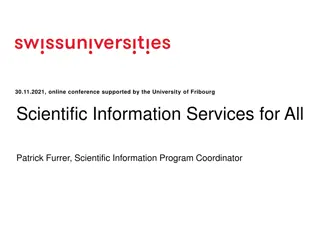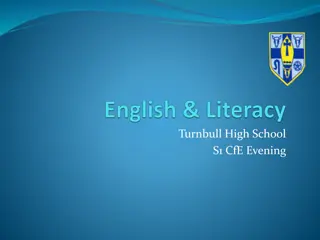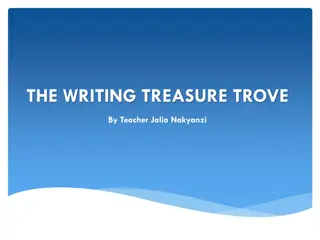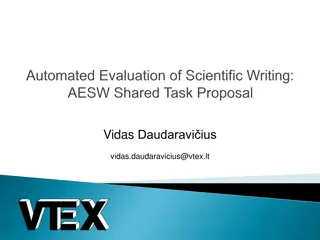Enhancing Scientific Article Writing Skills Among University Students
Addressing the low ability of university students to write scientific articles is crucial. This study explores strategies to improve students' scientific writing skills in Indonesia, focusing on the Genre-Based Writing Model Synthesized with Critical Literacy. By utilizing a qualitative approach with a quasi-experimental design, the research aims to enhance students' competencies in science communication. Insights from five key institutions in Indonesia shed light on the challenges and opportunities for developing effective scientific writing practices among students.
Download Presentation

Please find below an Image/Link to download the presentation.
The content on the website is provided AS IS for your information and personal use only. It may not be sold, licensed, or shared on other websites without obtaining consent from the author.If you encounter any issues during the download, it is possible that the publisher has removed the file from their server.
You are allowed to download the files provided on this website for personal or commercial use, subject to the condition that they are used lawfully. All files are the property of their respective owners.
The content on the website is provided AS IS for your information and personal use only. It may not be sold, licensed, or shared on other websites without obtaining consent from the author.
E N D
Presentation Transcript
THE ABILITY TO WRITE SCIENTIFIC ARTICLES AMONG UNIVERSITY STUDENTS VIEWS FROM FIVE INSTITUTIONS IN INDONESIA No. Abstract: ABS-ICOLLITE-23160 Hernawan, Dadang S. Anshari, Syihabuddin, Yeti Mulyati, Universitas Pendidikan Indonesia.
INTRODUCTION The low ability to write scientific articles in students must be addressed immediately. This factor is increasingly prominent when the learning model used is not in accordance with the learning outcomes of the course. Students as prospective scientists are prepared to have various competencies related to science, technology, and art according to the type of study program they are taking. Students are not only required to read scientific writings, but also must be able to write their own scientific works. Therefore, students must be able, skilled, master, develop, and disseminate knowledge by improving the skills of writing scientific articles.
LITERATURE REVIEW In 2015 the PISA test was held again. The Ministry of Education and Culture reported a fairly good increase in literacy in Indonesia. In 2015, out of 72 PISA participating countries, Indonesia was ranked 58th with a score of 397. This gave rise to new optimism for the Indonesian people to continue to strive to develop competencies, even though these 7 achievements were still below the OECD average (Damayantie, 2015, p. 6 ). In the 1970s and 1980s, the approach used in teaching writing was a process approach, which emphasized individual problem solving. through a planning-writing-reviewing framework (Badger & White, 2000; Flower & Hayes, 1981 in Kuiper , et al . ( 2017 p. 6). Hyland (2003) in Kuiper , et al . ( 2017 ) suggested that in the late 1980s and 1990s, the approach in learning switched to a genre approach. This approach emphasizes learning to write collaboratively within a contextual framework, highlighting the meaning and type of text. The genre approach emerged in Australia in the 1980s an ideological view that empowers all students with linguistic resources for social success (Cope & Kalantzis (1993) and Hyon, (1996) in Kuiper , et al . ( 2017 p. 6). The genre- based approach differs greatly from the naturalistic approach which sees language learning as primarily an individual phenomenon, as opposed to formal instructions of grammar and textual forms (Knapp & Watkins, 2005).
METHOD The approach used in this research is a qualitative approach with quasi-experimental research methods. The quasi-experimental design used is the one shot pretest-posttest design. Sources of data in this study were students from four universities in West Java. The number of students involved amounted to 144 students. The data collection technique used is test. According to Widoyoko (2013) a test is one of the tools used to take measurements in gathering information on an object. The data collection techniques used in this research are questionnaire techniques and performance test techniques. The questionnaire technique was used to obtain instrument validity data from experts and practitioners, while the test technique was used to measure students' skills in writing scientific articles after applying the Genre-Based Writing Model Synthesized with Critical Literacy. The data analysis technique used is descriptive data analysis technique. Descriptive analysis technique was performed using descriptive statistics.
FINDING AND DISCUSSION Average Score of Student Ability in Writing Articles 86 83.64 84 82 80 78 76 73.91 74 72 70 68 Rata-rata Tes Awal Tes Akhir
FINDING AND DISCUSSION Student Writing Ability from every Aspect 87.66 85.73 84.58 80.28 77.64 Periodisitas Fitur Linguistik Grafologi Gaya Penulisan Substansi Artikel
FINDING AND DISCUSSION As stated by (Hyland, 2009), each genre has a number of features that distinguish it from other genres: each has a specific purpose, structure, specific linguistic features, and is used by a cultural community. In this study, the aspects assessed in the students' scientific article writing consist of 1) periodicity, 2) linguistic features, 3) graphology, 4) writing style, and 5) article substance. Based on the statistical test results, it is known that the Asymp.Sig (2-tailed) value is 0.000. Because 0.000 <0.05, it can be concluded that the hypothesis is accepted. This means that there is a difference between the ability to write scientific articles using the GBWDLK model for initial and final test scores, so it can be concluded that there is an effect of developing the GBWDLK model on learning to write scientific articles in the broad test activity.
CONCLUSION After the implementation of the Genre-Based Writing Synthesised with Critical Literacy model, students' ability to write scientific articles in higher education increased significantly. Before the implementation of the GBWDLK model, the students' ability to write scientific articles was in the sufficient category, while after the implementation of the model, the students' ability became very good.
REFERENCES Damayantie, A. R. (2015). Literasi Dari Era Ke Era. Sasindo : Jurnal Pendidikan Bahasa Dan Sastra Indonesia, 3(1), 1 10. http://journal.upgris.ac.id/index.php/sasindo/article/view/2076 Hyland, K. (2009). Teaching and Researching Writing. In C. N. Candlin & D. R. Hall (Eds.), An International Handbook of Tourism Education (Second). Pearson Education Limited. Knapp, P., & Watkins, M. (2005). Genre, Text, Grammar. University of New South Wales Press Ltd. Kuiper, C., Kuiper, C., Smit, J., Wachter, L. De, & Elen, J. (2017). Scaffolding tertiary students writing in a genre-based writing intervention. June. https://doi.org/10.17239/jowr-2017.09.01.02 Widoyoko, S. E. P. (2013). Evaluasi Program Pembelajaran: Panduan Praktis bagi Pendidik dan Calon Pendidik. Pustaka Belajar.
THANK YOU! Follow us @hernawan_asgar
